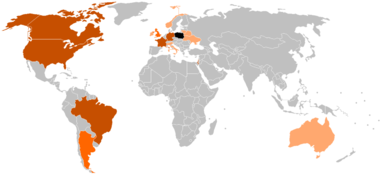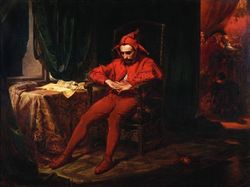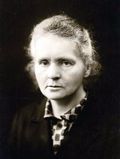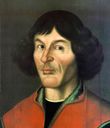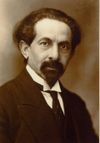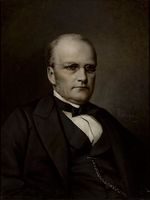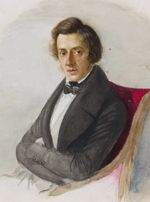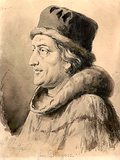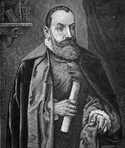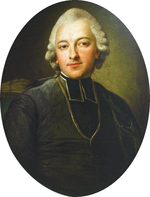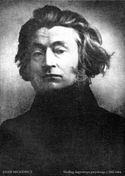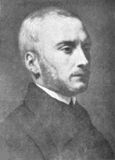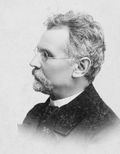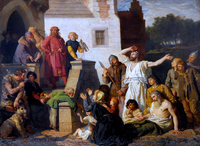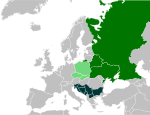پولنديون
| |||||||||||||||||||||||||||||||
| المناطق ذات التجمعات المعتبرة | |||||||||||||||||||||||||||||||
|---|---|---|---|---|---|---|---|---|---|---|---|---|---|---|---|---|---|---|---|---|---|---|---|---|---|---|---|---|---|---|---|
Polish diaspora | |||||||||||||||||||||||||||||||
| (500,000 Poles and 8,500,000 of Polish ancestry) | 9,000,000[2] | ||||||||||||||||||||||||||||||
| | 1,500,000 – 2,000,000[3][4] | ||||||||||||||||||||||||||||||
| | 1,800,000[5] | ||||||||||||||||||||||||||||||
| | 1,250,000[6] | ||||||||||||||||||||||||||||||
| | 1,010,705[7] | ||||||||||||||||||||||||||||||
| | 1,000,000[8] | ||||||||||||||||||||||||||||||
| | 630,000[9][10] | ||||||||||||||||||||||||||||||
| | 500,000[11] | ||||||||||||||||||||||||||||||
| | 294,549[12] | ||||||||||||||||||||||||||||||
| | 212,800[13] | ||||||||||||||||||||||||||||||
| | 216,056[14] | ||||||||||||||||||||||||||||||
| | 144,130[15] | ||||||||||||||||||||||||||||||
| | 122,585[16] | ||||||||||||||||||||||||||||||
| | 120,000[17] | ||||||||||||||||||||||||||||||
| | 109,018[18] | ||||||||||||||||||||||||||||||
| | 75,323[19] | ||||||||||||||||||||||||||||||
| | 73,000[20] | ||||||||||||||||||||||||||||||
| | 51,968[21] | ||||||||||||||||||||||||||||||
| | 44,783[22] | ||||||||||||||||||||||||||||||
| | 39,500[23] | ||||||||||||||||||||||||||||||
| | 34,057[24] | ||||||||||||||||||||||||||||||
| | 31,720[25] | ||||||||||||||||||||||||||||||
| | 30,000[26] | ||||||||||||||||||||||||||||||
| | 21,000[27] | ||||||||||||||||||||||||||||||
| | 10,540[28] | ||||||||||||||||||||||||||||||
| | 9,000[29] | ||||||||||||||||||||||||||||||
| | 7,000[30] | ||||||||||||||||||||||||||||||
| | 5,730[31] | ||||||||||||||||||||||||||||||
| | 4,174[32] | ||||||||||||||||||||||||||||||
| | 3,671[33] | ||||||||||||||||||||||||||||||
| | 3,084[34] | ||||||||||||||||||||||||||||||
| | 3,000[35] | ||||||||||||||||||||||||||||||
| | 2,200[36] | ||||||||||||||||||||||||||||||
| | 1,500[37] | ||||||||||||||||||||||||||||||
| | 1,000[38] | ||||||||||||||||||||||||||||||
| | 300[38] | ||||||||||||||||||||||||||||||
| Rest of world | 1,200 (est.)[39] | ||||||||||||||||||||||||||||||
| اللغات | |||||||||||||||||||||||||||||||
| Polish • Kashubian • Silesian | |||||||||||||||||||||||||||||||
| الدين | |||||||||||||||||||||||||||||||
| Predominantly Roman Catholicism Significant minorities of Eastern Orthodoxy, Protestantism (especially Lutheranism), Judaism and Non-Religious minorities | |||||||||||||||||||||||||||||||
| الجماعات العرقية ذات الصلة | |||||||||||||||||||||||||||||||
| Other Slavs (particularly West Slavs), Balts | |||||||||||||||||||||||||||||||
الپولنديون (پولندية: Polacy, pronounced [pɔˈlat͡sɨ]؛ المفرد المذكر: Polak، المفرد المؤنث: Polka) هم من يسكنون بولندا أو ينحدرون من أحد سكان بولندا، وهم مجموعة عرقية تنتمي إلى السلاف الغربيين، who share a common history, culture, the Polish language and are identified with the country of Poland in Central Europe. The preamble to the Constitution of the Republic of Poland defines the Polish nation as comprising all the citizens of Poland, regardless of heritage or ethnicity. ينتمي أغلبهم إلى الكاثوليكية.[40]
The population of self-declared Poles in Poland is estimated at 37,394,000 out of an overall population of 38,512,000 (based on the 2011 census),[1] of whom 36,522,000 declared Polish alone.[41][42][43] A wide-ranging Polish diaspora (the Polonia) exists throughout Europe, the Americas, and in Australasia. Today, the largest urban concentrations of Poles are within the Warsaw and Silesian metropolitan areas.
Ethnic Poles are considered to be the descendants of the ancient Lechites and other tribes that inhabited the Polish territories during the late antiquity period. Poland's recorded history dates back over a thousand years to ح. 930–960 AD, when the Western Polans – an influential tribe in the Greater Poland region – united various Lechitic clans under what became the Piast dynasty,[44] thus creating the first Polish state. The subsequent Christianization of Poland by the Catholic Church, in 966 CE, marked Poland's advent to the community of Western Christendom. However, throughout its existence, the Polish state followed a tolerant policy towards minorities resulting in numerous ethnic and religious identities of the Poles, such as Polish Jews.
Poles have made important contributions to the world in every major field of human endeavor, among them Copernicus, Marie Curie, Joseph Conrad, Frédéric Chopin and Pope John Paul II. Notable Polish émigrés – many of them forced from their homeland by historic vicissitudes – have included physicist Joseph Rotblat, mathematician Stanisław Ulam, pianist Arthur Rubinstein, actresses Helena Modjeska and Pola Negri, military leaders Tadeusz Kościuszko and Casimir Pulaski, U.S. National Security Advisor Zbigniew Brzezinski, politician Rosa Luxemburg, painter Tamara de Lempicka, filmmakers Samuel Goldwyn and the Warner Brothers, cartoonist Max Fleischer, and cosmeticians Helena Rubinstein and Max Factor.
. . . . . . . . . . . . . . . . . . . . . . . . . . . . . . . . . . . . . . . . . . . . . . . . . . . . . . . . . . . . . . . . . . . . . . . . . . . . . . . . . . . . . . . . . . . . . . . . . . . . . . . . . . . . . . . . . . . . . . . . . . . . . . . . . . . . . . . . . . . . . . . . . . . . . . . . . . . . . . . . . . . . . . . .
الأسماء والمسميات الأجنبية
The Polish endonym Polacy is derived from the Western Polans, a Lechitic tribe which inhabited lands around the River Warta in Greater Poland region from the mid-6th century onward.[45] The tribe's name stems from the Proto-Indo European *pleh₂-, which means flat or flatland and corresponds to the topography of a region that the Western Polans initially settled.[46][47] The prefix pol- is used in most world languages when referring to Poles (Spanish polaco, Italian polacche, French polonais, German Pole).
Among other foreign exonyms for the Polish people are Lithuanian Lenkai; Hungarian Lengyelek; Turkish Leh; بالأرمينية: Լեհաստան Lehastan; and فارسية: لهستان (Lahestān). These stem from Lechia, the ancient name for Poland, or from the tribal Lendians. Their names are equally derived from the Old Polish term lęda, meaning plain or field.[48]
الأصول
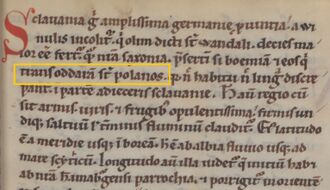
The territory of present-day Poland has been settled by various peoples and ethnic groups for centuries before the Polish state emerged in 966 AD. In late antiquity, these groups comprised Celtic, Scythian, Germanic, Sarmatian, Slavic and Baltic tribes.[49] During the Migration Period, the eastern parts of Magna Germania (today Poland) were becoming increasingly settled by the early Slavs (500–700 AD).[50] They organized into tribal units, of which the larger ones further west were later known as the Polish tribes (Lechites); the names of many tribes are found on the list compiled by the anonymous Bavarian Geographer in the 9th century.[51] However, there is strong evidence that Poles are the descendants of other ethnic groups which inhabited the Central European Plain long before the migration began and assimilated with time.[52] In the 9th and 10th centuries the tribes gave rise to developed regions along the upper Vistula (the Vistulans within the Great Moravian Empire sphere),[51] the Baltic Sea coast and in Greater Poland. The last tribal undertaking in the 10th century resulted in a lasting political structure and state.[53]
Throughout the centuries, Poland and its monarchs pursued a tolerant policy towards religious and ethnic minorities, which enhanced migration from other regions of Europe.[54] As the country expanded, so did its demographic composition – following the 1569 Union of Lublin, Poland joined neighbouring Lithuania in forming the Polish–Lithuanian Commonwealth, one of the largest countries on the continent at the time.[55] Thus, Lithuania's more multicultural society fell under Polish influence and societal integration between the two strengthened. No official statistics or records can precisely manifest the extent of the diversity – it is believed that among the largest groups were Poles, Lithuanians, Germans, Ruthenians (chiefly Ukrainians) and Jews. The Commonwealth also hosted refugees fleeing from persecution, or foreign traders and merchants including Czechs, Hungarians, Livonians, Romanis, Vlachs, Armenians, Italians, Scots and the Dutch.[56]
اللغة
The Polish language (پولندية: język polski) is a West Slavic language and the official language of Poland. Its written form uses the Polish alphabet, which is the Latin alphabet with the addition of a few diacritic marks.
الثقافة
العلوم والتكنولوجيا
Education has been of prime interest to Poland since the early 12th century. The catalog of the library of the Cathedral Chapter in Kraków dating from 1110 shows that Polish scholars already then had access to western European literature.
الموسيقى
الموسيقى التقليدية
. . . . . . . . . . . . . . . . . . . . . . . . . . . . . . . . . . . . . . . . . . . . . . . . . . . . . . . . . . . . . . . . . . . . . . . . . . . . . . . . . . . . . . . . . . . . . . . . . . . . . . . . . . . . . . . . . . . . . . . . . . . . . . . . . . . . . . . . . . . . . . . . . . . . . . . . . . . . . . . . . . . . . . . .
الأدب
العصور الوسطى
النهضة
الباروك
|
|
التنوير
الرومانسية
الإيجابية
الدين
انظر أيضاً
- Polonization
- Karta Polaka
- Polish nationality law
- Demographics of Poland
- List of Poles
- List of Polish Jews
- Name of Poland (etymology of the demonym)
- Pole, Hungarian, two good friends
- Poles in Germany
- Poles in Lithuania
- Poles in Romania
- Poles in the former Soviet Union
- Poles in the United Kingdom
- Polish Argentine
- Polish Australians
- Polish Brazilians
- Polish British
- Polish Canadians
- Polish minority in the Czech Republic
- Polish minority in France
- Polish Venezuelan
- Sons of Poland
الهامش
- ^ أ ب Central Statistical Office (2013). "The national-ethnic affiliation in the population – The results of the census of population and housing in 2011" (PDF) (in البولندية). p. 1. Retrieved 6 March 2013.
{{cite web}}: Unknown parameter|month=ignored (help) خطأ استشهاد: وسم<ref>غير صالح؛ الاسم "stat" معرف أكثر من مرة بمحتويات مختلفة. - ^ USA National Census 2010. Ancestries With 100,000 or More People in 2010. p. 5
- ^ (بالألمانية) Erstmals mehr als 16 Millionen Menschen mit Migrationshintergrund in Deutschland Statistisches Bundesamt Deutschland (German text about migrants in Germany)
- ^ (Polish) Raport o sytuacji Polonii i Polaków za granicą 2009. Ministerstwo Spraw Zagranicznych 2009. p. 177, ISBN 978-83-89607-81-2
- ^ Polonia w liczbach Stowarzyszenie Wspólnota Polska
- ^ Article on Ynet news site, Hebrew (Google translator).
- ^ "Ethnic Origin (264), Single and Multiple Ethnic Origin Responses (3), Generation Status (4), Age Groups (10) and Sex (3) for the Population in Private Households of Canada, Provinces, Territories, Census Metropolitan Areas and Census Agglomerations, 2011 National Household Survey".
- ^ Polish minority in France
- ^ "Polish diaspora in numbers" (in البولندية). association "Polish Community". Retrieved 21 November 2013.
- ^ British Office for National Statistics, Population by Country of Birth & Nationality, Jan 2009 to Dec 2009 with imigrants for 2012
^ (إنگليزية) Please note: The British Office for National Statistics recorded the number of Poles who have travelled to the UK in 2006 at over 2,000,000; they are not to be mistaken for permanent residents. - ^ http://edant.clarin.com/diario/2004/04/27/t-749506.htm
- ^ Belarus National Census 2009 (preliminary results)(in rus.)
- ^ [1]
- ^ 2006 Census Community Profile Series : Australia
- ^ Ukrainian Census 2001
- ^ Census 2011 Results
- ^ Aftenposten.no: - 120.000 polakker i Norge (Innenriks)
- ^ Istat.it
- ^ "Befolkning efter födelseland och ursprungsland 31 december 2012". Statistics Sweden. 31 December 2013. Retrieved 22 December 2013. (Swedish)
- ^ Polish minority in Russia, WorldNews.com
- ^ Czech Republic National Census 2001 (PDF)
- ^ [2]
- ^ http://www.cbs.nl/NR/rdonlyres/CCD504EA-9D41-40C2-AE28-BFB0A51C2045/0/2005k3b15p096art.pdf
- ^ Kazakhstan National Census 2009
- ^ "Statistics Denmark:FOLK2: Population 1. January by sex, age, ancestry, country of origin and citizenship". Statistics Denmark. Retrieved 3 August 2012.
- ^ http://www.wspolnota-polska.org.pl/index.php?id=dubd2
- ^ Poles in AustriaPDF
- ^ Mannfjöldi eftir fæðingarlandi 1981-2008: Pólland
- ^ http://www.joshuaproject.net/countries.php?rog3=VE
- ^ http://www.espejodelperu.com.pe/Poblacion-del-Peru/Migraciones-europeas-minoritarias.htm
- ^ http://www.ksh.hu/docs/hun/xftp/idoszaki/nepsz2011/nepsz_orsz_2011.pdf 2011 Census of Hungary
- ^ 2004 Moldovan census, including Transnistria
- ^ 2002 Romanian census.
- ^ http://portal.statistics.sk/files/tab.11.pdf
- ^ http://www.helsinki.polemb.net/index.php?document=46
- ^ pl:Estonia#Polacy w Estonii
- ^ http://m.eluniversal.com.co/colombia/comenzo-la-cuenta-regresiva-para-eliminar-la-visa-schengen-151003
- ^ أ ب Polonezkoy.com
- ^ Poles around the World (>polonia > statystyka)
- ^ خطأ استشهاد: وسم
<ref>غير صحيح؛ لا نص تم توفيره للمراجع المسماةStat - ^ Gudaszewski, Grzegorz (November 2015). Struktura narodowo-etniczna, językowa i wyznaniowa ludności Polski. Narodowy Spis Powszechny Ludności i Mieszkań 2011 (PDF). Warsaw: Główny Urząd Statystyczny. pp. 132–136. ISBN 978-83-7027-597-6.
- ^ Struktura narodowo-etniczna, językowa i wyznaniowa ludności Polski [Narodowy Spis Powszechny Ludności i Mieszkań 2011] (PDF) (in البولندية). Warsaw: Główny Urząd Statystyczny. November 2015. pp. 129–136. ISBN 978-83-7027-597-6.
- ^ خطأ استشهاد: وسم
<ref>غير صحيح؛ لا نص تم توفيره للمراجع المسماةLudność - ^ Gerard Labuda. Fragmenty dziejów Słowiańszczyzny zachodniej, t.1–2 p.72 2002; Henryk Łowmiański. Początki Polski: z dziejów Słowian w I tysiącleciu n.e., t. 5 p.472; Stanisław Henryk Badeni, 1923. p. 270.
- ^ Gliński, Mikołaj (6 December 2016). "The Many Different Names of Poland". Culture.pl. Retrieved 31 March 2019.
- ^ Lehr-Spławiński, Tadeusz (1978). Język polski. Pochodzenie, powstanie, rozwój. Warszawa (Warsaw): Państwowe Wydawnictwo Naukowe. p. 64.
- ^ Potkański, Karol (2004) [1922]. Pisma pośmiertne. Granice plemienia Polan. Vol. 1 & 2. Kraków: Polska Akademia Umiejętności. p. 423. ISBN 9788370634117.
- ^ Małecki, Antoni (1907). Lechici w świetle historycznej krytyki. Lwów: Zakład Narodowy im. Ossolińskich. p. 37. ISBN 9788365746641.
- ^ Davies, Norman (2001). Heart of Europe. The Past in Poland's Present (in الإنجليزية). Oxford: Oxford University Press. p. 247. ISBN 9780192801265.
- ^ Zbigniew Kobyliński. "The Slavs" in Paul Fouracre. The New Cambridge Medieval History, pp. 530–537
- ^ أ ب Davies, Norman (2005). God's Playground A History of Poland: Volume 1: The Origins to 1795: Origins. OUP Oxford. p. xxvii. ISBN 978-0199253395.
- ^ Mielnik-Sikorska, Marta (2013), "The History of Slavs Inferred from Complete Mitochondrial Genome Sequences", PLOS ONE 8 (1): e54360, doi:, PMID 23342138, Bibcode: 2013PLoSO...854360M
- ^ Derwich, Marek; Żurek, Adam (2002). U źródeł Polski (do roku 1038) (in البولندية). pp. 122–143.
- ^ # Norman Davies, God's Playground. A History of Poland, Vol. 1: The Origins to 1795, Vol. 2: 1795 to the Present. Oxford: Oxford University Press. ISBN 0-19-925339-0 / ISBN 0-19-925340-4
- ^ Butterwick, Richard (2021). The Polish-Lithuanian Commonwealth, 1733-1795. Yale University Press. p. 21. ISBN 9780300252200.
- ^ Kopczyński, Michał; Tygielski, Wojciech (2010). Pod wspólnym niebem. Narody dawnej Rzeczypospolitej (in البولندية). Warszawa: Bellona. ISBN 9788311117242.
- ^ Karol Badecki, "Pisma Jana Dzwonowskiego (1608-1625)." Wydawnictwa Akademii Umiejętności w Krakowie. Biblioteka Pisarzów Polskich. Kraków. Nakładem Akademii Umiejętności. 1910. 119s. (Polish)
. . . . . . . . . . . . . . . . . . . . . . . . . . . . . . . . . . . . . . . . . . . . . . . . . . . . . . . . . . . . . . . . . . . . . . . . . . . . . . . . . . . . . . . . . . . . . . . . . . . . . . . . . . . . . . . . . . . . . . . . . . . . . . . . . . . . . . . . . . . . . . . . . . . . . . . . . . . . . . . . . . . . . . . .
وصلات خارجية
- CS1 errors: unsupported parameter
- CS1 البولندية-language sources (pl)
- "Related ethnic groups" needing confirmation
- Pages using infobox ethnic group with unsupported parameters
- Articles using infobox ethnic group with image parameters
- Articles containing پولندية-language text
- Articles with hatnote templates targeting a nonexistent page
- Articles containing أرمنية-language text
- Articles containing فارسية-language text
- Pages using div col with unknown parameters
- Polish people
- Ethnic groups in Poland
- جماعات عرقية في أوروپا
- Lechites
- جماعات عرقية سلاڤية
























